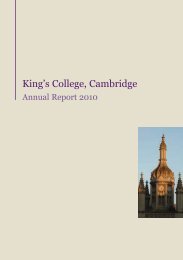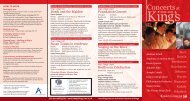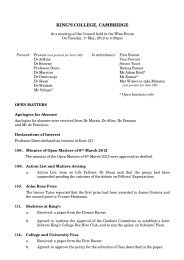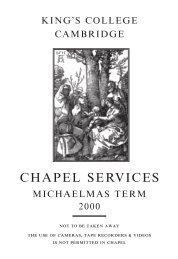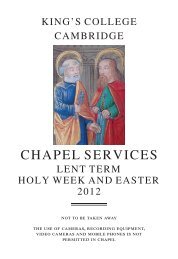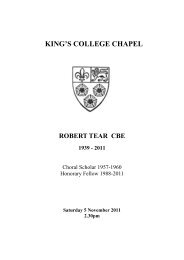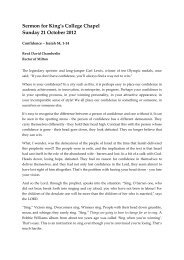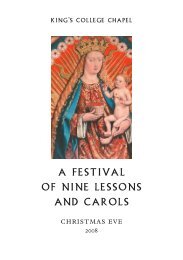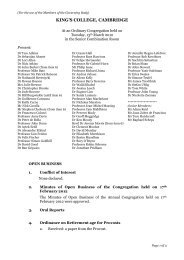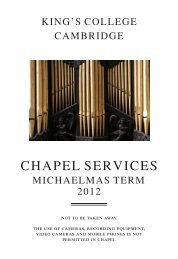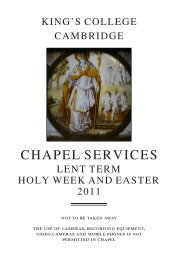Part 2 (Obituaries) - King's College - University of Cambridge
Part 2 (Obituaries) - King's College - University of Cambridge
Part 2 (Obituaries) - King's College - University of Cambridge
You also want an ePaper? Increase the reach of your titles
YUMPU automatically turns print PDFs into web optimized ePapers that Google loves.
98<br />
OBITUARIES<br />
born in Coventry on 27 February 1926 and attended Uppingham School. In<br />
1949 he married his wife Diana and for many years he was a Director <strong>of</strong><br />
Fownes Gloves Ltd in Worcester. Michael and Diana lived in Malvern for over<br />
40 years before his death on Christmas Day 2005.<br />
THOMAS DOUGLAS CARNWATH (1930) was born on 19 November<br />
1911. He came to King’s from Eton and read Maths and Economics. He was<br />
then articled to the chartered accountants Peat, Marwick, Mitchell & Co in<br />
London and qualified as a Chartered Accountant in 1938. In 1939 Thomas<br />
joined the Honourable Artillery Company before being commissioned into<br />
the Royal Signals in 1940, where he served in the UK and India and achieved<br />
the rank <strong>of</strong> Major. In 1942 he married Winifred Stewart.<br />
In 1945 Thomas returned to chartered accountancy and from 1961 to 1975<br />
was a <strong>Part</strong>ner at Peat, Marwick, Mitchell & Co.Winifred died in 1983, and in<br />
1989 Thomas married Berit Stiernstedt. He died on 4 February 1998.<br />
DAVID DUNBAR CARROW (1947), son <strong>of</strong> R B C (1911), died on 26<br />
September 2004 from the after-effects <strong>of</strong> a fall. He is survived by his son<br />
Richard Carrow. His beloved wife Barbara and daughter Julia Holroyd had<br />
predeceased him.<br />
David was born on 22 March 1922 in the Avon Valley. He was educated at<br />
Harrow after which he joined the RAF at the height <strong>of</strong> the war in 1942. His<br />
mathematical skills brought him to the top 5 per cent <strong>of</strong> his navigational<br />
training course, and he was posted to the Coastal Command on<br />
meteorological flights.<br />
Flying the “Met Flight” brought him into close contact with an attacking<br />
enemy fighter only once, but he was not to stay in this relatively safe posting.<br />
At an RAF squadron flying Halifaxes out <strong>of</strong> Tarrant Rushton in Dorset, David<br />
came much closer to the war. His job was to tow gliders to positions from<br />
which they could be launched and to carry troops into enemy territory.



